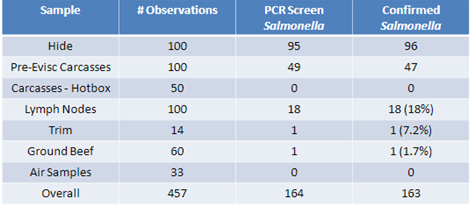Project Summary
Source Attribution of Salmonella in Ground Beef in Non-fed Processing Plants
- Principle Investigator(s):
- Mohammad Koohmaraie, John Scanga, Mike De La Zerda, Bijan Koohmaraie, and Mansour Samadpour
- Institution(s):
- IEH Laboratories & Consulting Group
- Completion Date:
- 2010
Background
Salmonella in ground beef continues to represent a major challenge for the non-fed sector of the U.S. beef processing sector. Because of the USDA regulations with respect to the presence of Salmonella in ground beef destined for the school lunch program and in general USDA focus on Salmonella, it behooves the industry to bring the same level of focus in controlling Salmonella as that of controlling E. coli O157:H7. A number of Checkoff funded projects have determined the prevalence of Salmonella at various steps in processing. These projects have also determined that lymph nodes can be a significant source of Salmonella. Because the lymph nodes from shank and brisket are not removed in non-fed plants and are subsequently ground, lymph nodes can be a major source of Salmonella in ground beef. The other primary source of Salmonella in ground beef is carcass surface tissue (originating from hide). In this project the researchers set out to determine the relative contributions of the lymph nodes and carcass in the prevalence of Salmonella in ground beef. Samples were sourced from carcasses, flank lymph nodes from the same carcasses, brisket lymph nodes from the same carcasses and ground beef made from the same carcasses. The intent is to obtain fingerprint of Salmonella isolates from each of the above samples. Comparing the fingerprints observed in ground beef with that of lymph nodes and carcasses will enable the determination of the most probable source of Salmonella in ground beef. This information should enable the industry to better control the presence of Salmonella.
The objectives of the study were to:
- Determine the prevalence of Salmonella on cow carcasses after hide removal and before any intervention.
- To conduct PFGE analysis on Salmonella isolates from carcass samples.
- Determine the prevalence of Salmonella in lymph nodes from chuck and flank of the same carcasses sampled above.
- To conduct PFGE analysis on Salmonella isolates from lymph nodes.
- To determine the prevalence of Salmonella in ground beef produced from carcasses sampled above.
- To conduct PFGE analysis of the Salmonella isolated from lymph nodes
- Using the above information, determine the most likely source of Salmonella in ground beef and recommend appropriate measures to reduce or eliminate Salmonella from ground beef.
100 dairy cows were sampled throughout the harvest process. After harvest, hides were sampled, and after hide removal, carcasses were sampled prior to any interventions. After overnight chilling, carcasses were fabricated as a group and trim produced from these carcasses were collected and sampled. Trim was tested for E. coli O157:H7 by the cooperating plant and according to their standard protocol and the sample was found to be negative for E. coli O157:H7. Trim from theses carcasses were then ground separately and sampled frequently. Superficial cervical lymph nodes were obtained from the chuck of all 100 carcasses. The air was also sampled at each sampling site (harvest floor, fabrication and grinding facilities). All sampled were analyzed for the presence of Salmonella and all Salmonella isolates were analyzed by Pulse-Field Gel Electrophoresis (PFGE).
Findings
Results indicate that while none of the air samples were positive for Salmonella, all animal/carcass samples had at least one positive sample for Salmonella (see the Table below). Of 457 samples collected, 163 were confirmed to be positive for Salmonella (35.7%). As expected, the highest number of positive Salmonella samples (96%) was attributed to hide samples, followed by carcasses right after hide removal (47%). 18% of lymph nodes, 7.2% of trim and 1.7% of ground beef were positive for Salmonella. The PFGE results indicated that ground beef Salmonella had a similar pattern as that of carcass and hide isolates, but the trim isolate had the same pattern as that of lymph nodes. If sampling errors due to no random distribution of Salmonella were accounted for, the conclusion is that the predominant (if not the sole) sources of Salmonella (including multi-drug resistant Salmonella) are hide and lymph nodes.
IMPLICATIONS
In 2009 for the first time ever, more ground was recalled due to the presence of MDR Salmonella than E. coli O157:H7. In a number of industry sponsored meetings, the USDA officials have made it clear that unless the industry addresses the issue, Salmonella could also become an adulterant in trim and ground beef. To avoid such a regulatory outcome, the beef industry needs to prevent more recalls due to MDR Salmonella. Knowing the source of MDR Salmonella is required for its control in ground beef. This project was therefore conducted to determine the source of MDR Salmonella in ground beef. Results indicate that hide and lymph nodes are the source of MDR Salmonella in ground beef. The researchers have disseminated this information to the industry, and the researchers are collectively attempting to use this information to control MDR Salmonella in beef.
